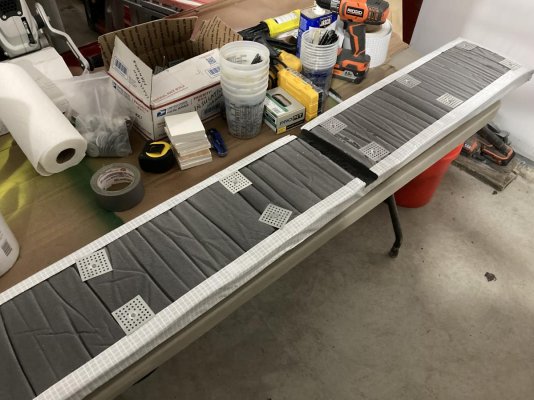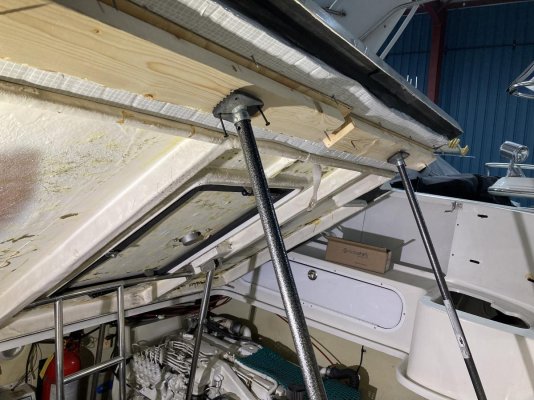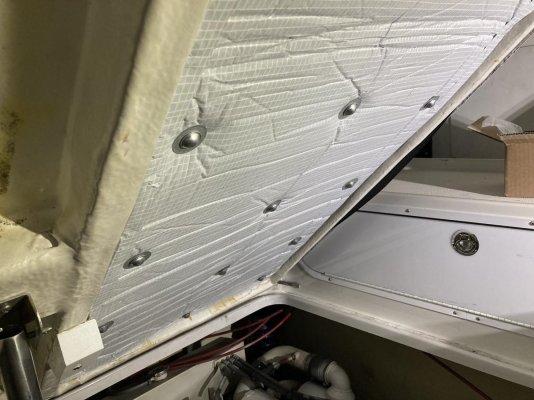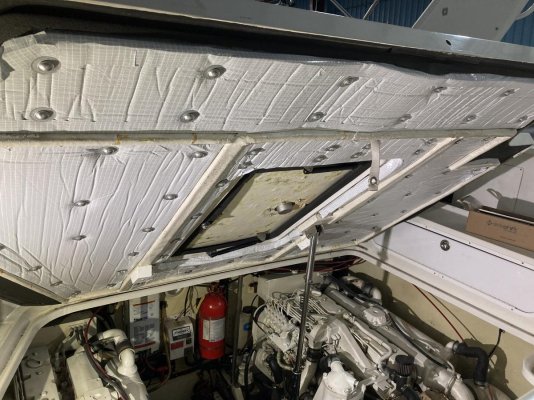Comodave
Moderator Emeritus
- Joined
- Jul 2, 2015
- Messages
- 21,283
- Location
- Au Gres, MI
- Vessel Name
- Black Dog
- Vessel Make
- Formula 41PC
Our Formula 41PC with 450 Cummins was in need of some better sound insulation than the inadequate sound insulation that was installed by Formula. They put in 1/2” foam with a vinyl cover. It looked nice but didn’t do much for diesel noise. We are putting in 2” 2 pound per square foot insulation. It is comprised of 1” foam with PSA bonded to a mineral loaded vinyl layer with another 1” of foam bonded to that and topped by a white mylar. We used the old foam as a template to layout the new insulation. Took a jigsaw with a laminate cutting blade (downward cutting teeth) and easily cut out the new insulation. We then drilled holes in the new insulation. Reverse the drill to drill the foam, then forward to drill the loaded vinyl layer and then reverse to drill the bottom layer of foam. We spaced the brackets to hold up the insulation about 9” apart. After drilling the holes for the pin brackets we inserted the pins through the insulation from the PSA side. Then put a spoonful of thickened epoxy on each pin bracket. Then the fun part, carefully position the piece of insulation in place. You only get one chance as the PSA will quickly grab onto the substrate. We then used a variety of things to prop the insulation in place overnight. Soundown said the PSA will gain in strength in the first 24 hours so we wanted it held firmly in place for that time. Also the epoxy will take 4 to 6 hours to setup. We had a couple of racheting poles used in pickup beds to hold stuff from sliding around. They turned out to be the perfect thing to hold the insulation in place. We used plywood and 2x4s against the insulation and the rachet poles to put pressure up on the wood. So far it has worked very well. After the PSA and epoxy have setup we removed the supports and cut the pins to lenght. Then put on the one way washers and caps onto the pins.
Attachments
-
 FCD73F04-DFCC-4FFD-8AA8-9959181AB364.jpg147.6 KB · Views: 80
FCD73F04-DFCC-4FFD-8AA8-9959181AB364.jpg147.6 KB · Views: 80 -
 ED57CE1F-D2FF-46C4-AE52-C429FE6A5810.jpg101.8 KB · Views: 74
ED57CE1F-D2FF-46C4-AE52-C429FE6A5810.jpg101.8 KB · Views: 74 -
 A46B3C3E-4533-45BE-8130-5A853D876882.jpg168.2 KB · Views: 74
A46B3C3E-4533-45BE-8130-5A853D876882.jpg168.2 KB · Views: 74 -
 9A1DB821-50D8-476C-86D7-E53F3D51F432.jpg166.8 KB · Views: 70
9A1DB821-50D8-476C-86D7-E53F3D51F432.jpg166.8 KB · Views: 70 -
 CAA519F8-7967-404C-8395-A2958400187E.jpg133.7 KB · Views: 70
CAA519F8-7967-404C-8395-A2958400187E.jpg133.7 KB · Views: 70 -
 A6002D33-52C1-4602-B25A-43BF605FDF9F.jpg137.1 KB · Views: 75
A6002D33-52C1-4602-B25A-43BF605FDF9F.jpg137.1 KB · Views: 75





